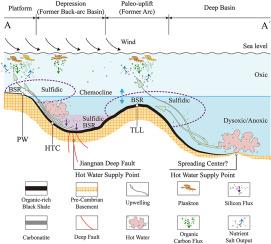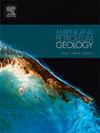中国长江下游南地台早寒武纪古海洋环境与有机质富集机制
IF 3.6
2区 地球科学
Q1 GEOSCIENCES, MULTIDISCIPLINARY
引用次数: 0
摘要
本研究以位于安徽省南部的长江下游地台为研究对象,以早寒武世荷塘地层黑色页岩为主要研究对象。研究选取了代表不同沉积结构单元的三个野外剖面。研究采用了包括有机地球化学、元素地球化学和扫描电子显微镜在内的分析方法来重建古海洋环境条件。这些分析旨在阐明海洋表层生产力的特征,确定控制有机质形成的因素,从而建立有机质积累过程的模型。这些研究结果表明,江南古隆起对有机质的形成和积累具有不同的控制作用。具体而言,古隆起的屏障功能在某些区域形成了相对封闭和受限的水环境,有利于有机质的形成、积累和保存。此外,古上升流系统和江南深断裂激活引发的热液地下水循环在控制早寒武纪有机质的形成和积累方面发挥了关键作用。值得注意的是,研究还揭示了间歇性热液活动对不同古海洋环境中有机质积累的双重影响。这一过程可能会促进有机物的富集,并导致有机物浓度的稀释。本文章由计算机程序翻译,如有差异,请以英文原文为准。

The paleo-oceanic environment and organic matter enrichment mechanism of the early Cambrian in the southern Lower Yangtze platform, China
This study focuses on the Lower Yangtze Platform located in southern Anhui Province, focusing on the black shale of the early Cambrian Hetang Formation as the primary research subject. Three field sections representing distinct sedimentary structural units were selected for investigation. Analytical methodologies encompassing organic geochemistry, elemental geochemistry, and scanning electron microscopy were employed to reconstruct paleo-oceanic environmental conditions. These analyses aimed to elucidate the characteristics of marine surface productivity and identify the factors controlling organic matter formation, thereby establishing a model for organic matter accumulation processes. These findings suggest that the Jiangnan paleo-uplift exerted differentiated control over organic matter formation and accumulation. Specifically, the barrier function of the paleo-uplift fostered a relatively enclosed and restricted water environment in certain regions, which proved conducive to the formation, accumulation, and preservation of organic matter. Furthermore, the paleo-upwelling system and hydrothermal groundwater circulation triggered by the activation of the Jiangnan deep fault played crucial roles in controlling the formation and accumulation of organic matter in the early Cambrian. Notably, the research also revealed that intermittent hydrothermal activity had a dual impact on organic matter accumulation within various paleo-oceanic settings. This process potentially facilitated organic matter enrichment and led to the dilution of organic matter concentrations.
求助全文
通过发布文献求助,成功后即可免费获取论文全文。
去求助
来源期刊

Marine and Petroleum Geology
地学-地球科学综合
CiteScore
8.80
自引率
14.30%
发文量
475
审稿时长
63 days
期刊介绍:
Marine and Petroleum Geology is the pre-eminent international forum for the exchange of multidisciplinary concepts, interpretations and techniques for all concerned with marine and petroleum geology in industry, government and academia. Rapid bimonthly publication allows early communications of papers or short communications to the geoscience community.
Marine and Petroleum Geology is essential reading for geologists, geophysicists and explorationists in industry, government and academia working in the following areas: marine geology; basin analysis and evaluation; organic geochemistry; reserve/resource estimation; seismic stratigraphy; thermal models of basic evolution; sedimentary geology; continental margins; geophysical interpretation; structural geology/tectonics; formation evaluation techniques; well logging.
 求助内容:
求助内容: 应助结果提醒方式:
应助结果提醒方式:


